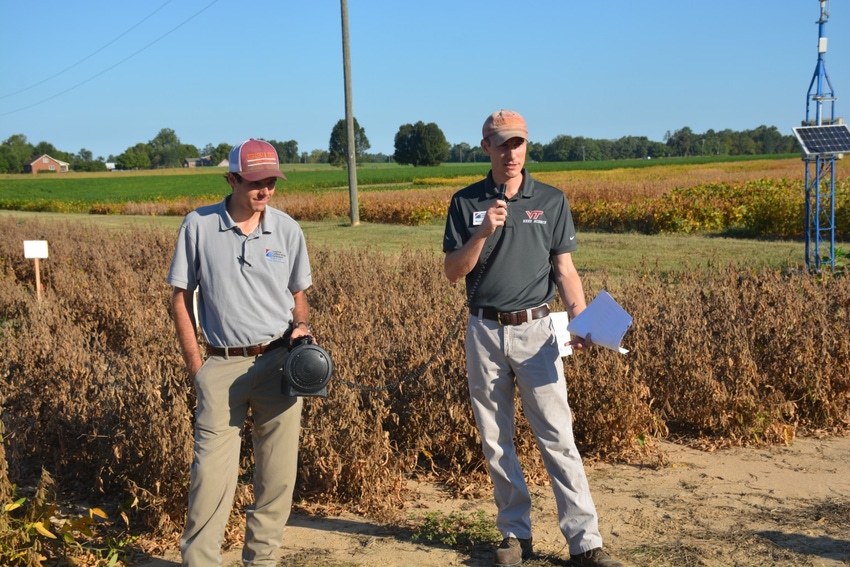
Soybean farmers can take steps to avoid herbicide injury by selecting the right herbicide, using the right rate and adapting the right tillage practices to protect soybean plants.
Speaking at the Soybean Field Day at the Eastern Virginia Agricultural Research and Extension Center in Warsaw Sept. 24, Dr. Michael Flessner, assistant professor and Extension weed science specialist with Virginia Tech and Virginia Cooperative Extension, pointed out that with soil applied herbicides and some of the post-emergence herbicides used on soybeans today, there is risk of soybean injury.
It’s something farmers need to be on the lookout for, but not panic over because soybeans are resilient and can usually bounce back from injury and most of the injury is often cosmetic and wont impact yield.
“I would rather have a little bit of injury on my soybeans and good weed control than no injury on my soybeans but a weedy mess. That’s going to cost us more in yield,” Flessner said.
There are two big players in soil applied herbicides in soybeans: Flumioxazin and sulfentrazone. Flumioxazin is a broad-spectrum contact herbicide that works by interfering with a plant’s production of chlorophyll. Sulfentrazone is a PPO inhibitor.
“Flumioxazin is a little hotter. It can result in a little splash-up injury. Sulfentrazone is a little bit safer. If we’re in a medium-textured soil, I like flumioxazin a little bit better because I think it results in as good and sometimes slightly better weed control than sulfentrazone,” Flessner said.
“But if you’re in the Coastal Plain or Eastern Shore of Virginia, where we have sandy, course-textured soils, I think sulfentrazone is probably where you want to go,” he added.
Soybean farmers can mix group 15 herbicides such a Dual, Zidua or Warrant, but Flessner said they need to be careful, because some of these herbicide combinations are off label. For example, a combination of Dual and Valor is off label in soybeans because it can result in injury to soybean plants.
“The other thing we can control is tillage. Conventionally-tilled soil is most likely to result in soybean injury because of the soil profile. The herbicide can work down and get into that seedling a little easier than in a no-till situation. Keeping a lot of residue is going to prevent some of that splash up injury,” Flessner explained.
“When we put that herbicide down, it’s basically on the surface, whether that’s the residue or the soil. A rainstorm with big heavy drops can actually splash the herbicide up onto the soybean seedling, and then you will see speckling necrosis. A soybean plant can usually take a little bit of injury and it will grow out of it. Having that residue will help you,” he said.
Planting depth is important. “Obviously we want to plant our soybeans where they can get moisture. Generally, the deeper we plant, the safer it’s going to be. I haven’t seen much difference past one inch of depth. When we plant shallow, we are closer to that herbicide zone. That is something we can control,” Flessner explained.
Still, there are many things farmers can’t control such as a prolonged rain. With a prolonged wet period and a saturated soil profile, herbicides are going to be more available for root uptake by soybean plants which typically results in greater injury.
“Plus, soybean plants are going to be slower growing under wet conditions and sometimes won’t be able to grow out of those situations,” Flessner explained.
“Sometimes, soybean plants will see some stunting from flumioxazins such as Valor. We also see some draw string injury from Group 15 herbicides like Warrant and Zidua. It makes kind of a heart-shaped leaf, which is entirely cosmetic,” Flessner said. “It’s something you can see fairly often if you know what you are looking for.”
Post emergent herbicides can cause injury as well, such as spotted necrosis, but Flessner stressed this is largely cosmetic and doesn’t necessarily mean a yield loss. In his research, Flessner and his team have tried to show a yield loss from the injury, but they haven’t been able to do so.
“With Cobra, we expect to see 35 to 40 percent leaf burn a couple weeks after treatment. The plant puts on new leaves and basically covers up the injury. With Flexstar and Ultra Blazer, we see five to 10 percent injury two weeks later, but no yield loss. It’s entirely cosmetic,” Flessner said.
About the Author(s)
You May Also Like






